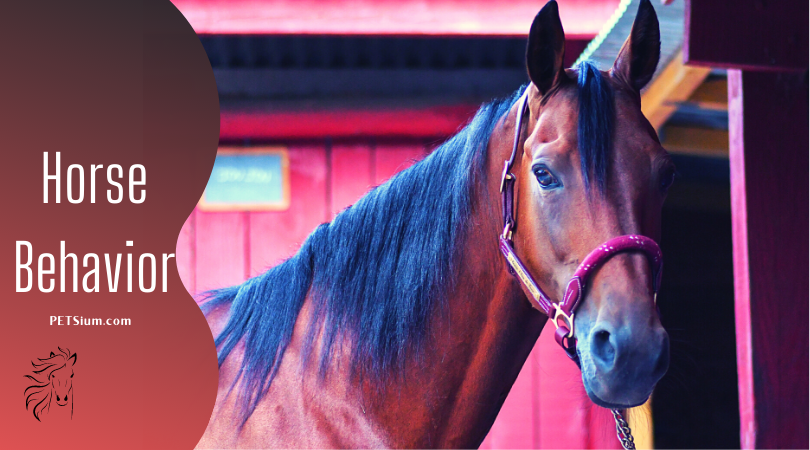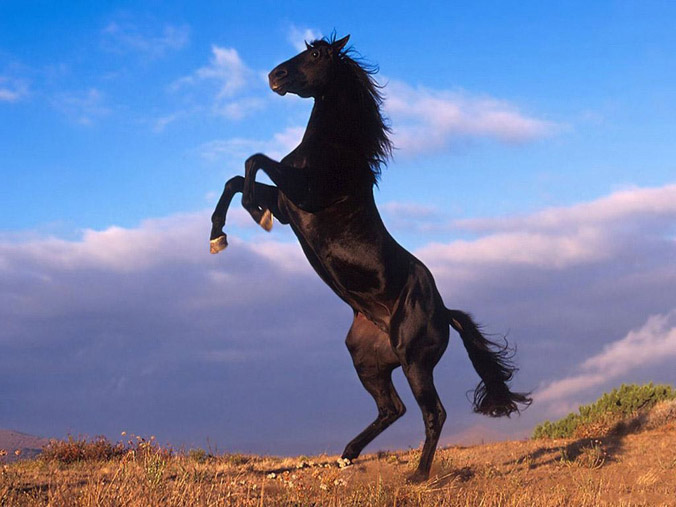Behavior is a unique characteristic of any animal, and horses are no exception. Although, some habits might be common to a specie, individual behavior might differ. It is a very confusing aspect.
Horses that share a similar trait might not have similar habits. If we can understand a horse’s behavior then it would enhance our relationship with the animal. In this chapter, we would read some common habits that horses have.

Post Navigation
Group Activity
Horses prefer to stay in groups. They tend to build up a strong relationship amongst each other when they live together. They do not fight amongst each other for food or water but live very peacefully when kept together. It is because of their social nature that they go along well with human beings and can prove to be faithful companions.
Communication
Like any other animal, horses too have their own ways of communicating. They communicate through sounds and actions and by looking at their behavior we can come to know what they are trying to say. The sounds and actions vary and we can know when the horse is frightened or alarmed or if the horse is in a friendly mood or unfriendly mood. These vary from animal to animal and these behaviors can be understood only when there is a close interaction with the animal.
A Sound and its meaning:
Neigh: This is the most common and familiar sound that a horse makes. The horse uses this sound to greet a passerby and if the sound is high pitched and loud then it means that the horse is trying to locate a missing foal.
Whinny: This is a softer form of a neigh and this sound is used by the horse to show affection or greet friends. Whinny can also mean that the horse wants a treat.
Nicker: This sound is a low and soft one and this is also used for greeting friends and the horse also uses this sound as a thank-you sound when a treat is given to him.
Squeals and screams: These are unfriendly sounds and a signal of anger or unhappiness. The horse often uses this sound along with slapping the ears and wrinkling his nostrils. If the horse makes such a sound and action, then it can be a sign of a probable bite from the horse.
When a horse is in a confronting mood he will start screaming and also make some actions like shaking the head and continual stomping of his hooves.
Horses respond rapidly to touch. They can feel the type of contact that other humans or animals make and react accordingly. For example a horse responds to the touch of the riders feet and runs accordingly. Smelling sense of horses is very strong. They often recognize individuals by the smell.
Control Your Horse / Horses
We would now see as to how you can control your horse. Before that let us see how horses instinctively behave.
As mentioned earlier, horses prefer to be in groups or herds, to be precise. This basic nature of horses comes because horses feel insecure. Due to insecurity, they are very repulsive and tend to react with the slightest disturbance. Such behavior is very important to understand to be able to coordinate with your horse. Give them safety, and they are yours!
Horses easily accept dominance as long as they feel secure. Body language is an excellent way to communicate with horses. They can sense your way of movement, speech, tone of voice and decide whether you can control him or not.
You have to be dominant over your horse. Never go back when your horse is approaching you. This would make him feel that you would not be able to provide security and will try to be dominant over you.
Dominance on your part should not bring along harshness or cruelty to your horse. Be firm but polite with your horse. This would enhance the relationship between you and your horse, and the horse will learn to respect you and obey to all your orders.
Horses express their feelings through their own body language. If your horse moves his feet rapidly, he is feeling insecure. One distinct behavior is that a horse feels safer in moving his feet.
A horse that fears something would have flaring nostrils, head held high, stiff tail, and ears held against the head. However, similar expressions can be seen when the horse is under aggression. On the other hand, a relaxed horse will have his head down, and ears relaxed.
Bad habits that should be taken care of by experts
Horses can get frustrated at times. This could be due to boredom or improper physical conditions; sometimes created by human beings. Some of the most common actions that horses do when they feel neglected are cribbing and weaving. Cribbing would mean that the horse would start biting solid objects. Weaving mans that the horse would rock his body and head.

Some horses even tear rugs out of boredom. Some actions like bolting, bucking and rearing could be due to an improper saddle. Bolting is a result of improper tacking. This is very dangerous as the horse tends to get rid of what causes him trouble.
A horse bucks in order to get rid of predators and strangers. This could also be due to improper tacks that trouble the horse. Rearing means rising on the rear legs. This is very dangerous and should be taken care of by expert riders.
Behavior – Likes and Dislikes
Horses like friends, so be as friendly as you can. Provide comfort to your horse both emotionally and physically. Horses love to eat! Your horse loves to be brushed. So don’t forget brushing your horse properly.
Horses never like pain. Try to avoid injuries and hurting saddles. Horses hate to be confined. They love to explore. Give room to your horse and sometimes, leave it alone (but not for too long).
Behavior – Some Other Factors
There are some other factors that influence the behavior of a horse.
One most important factor is the age. Although, different horses tend to mature at different ages, many of them are matured enough at around seven years. When horses reach their level of maturity, they tend to be more obedient and sober.
Another important factor is the gender of horses. Mares show more maturity than their male counterparts. However, geldings are the most suitable when it comes to calmness. They are the most suited for children and novice riders.
A lot of your horse’s behavior would depend upon the training that it receives. Sometimes, the horse’s behavior will greatly influence the style of training to be imparted to the horse. Make sure that proper training is imparted to make your horse a pleasure to be with!
Warning! Make sure you stick to the following rules when it comes to horses:
- Always approach a horse from the front side and not the rear side.
- Feed the horse in front of the owner.
- Avoid sudden movements and unusual sounds in front of horses.




